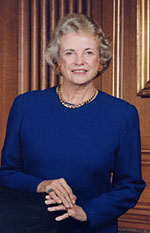 One of my heroes is Sandra Day O'Connor. She's an easy figure to respect for being a trailblazer in the legal profession and a powerful role model. She created a practical, balanced, non-doctrinaire school of jurisprudence, criticized by some as too variable for the requirements of modern law and bitterly condemned by others for failing to vote as anticipated when she was elevated to the U.S. Supreme Court by President Reagan in 1981, back when I was ten years old and had not yet learned to care about the legal system. At the time, I did not appreciate what a big deal it was that a woman would hold such a position and today it is taken for granted that a woman could and would do so. But it took a special sort of person to be the first, and I now have a better appreciation of what went into molding her into the person she became.
One of my heroes is Sandra Day O'Connor. She's an easy figure to respect for being a trailblazer in the legal profession and a powerful role model. She created a practical, balanced, non-doctrinaire school of jurisprudence, criticized by some as too variable for the requirements of modern law and bitterly condemned by others for failing to vote as anticipated when she was elevated to the U.S. Supreme Court by President Reagan in 1981, back when I was ten years old and had not yet learned to care about the legal system. At the time, I did not appreciate what a big deal it was that a woman would hold such a position and today it is taken for granted that a woman could and would do so. But it took a special sort of person to be the first, and I now have a better appreciation of what went into molding her into the person she became.O'Connor's family memoir, Lazy B, is not about how she became a lawyer or how she entered politics or how she rose to the very pinnacle of the legal profession -- at least, not directly. Those things are mentioned, but the focus of the book is elsewhere. It is a loving, unblinking portrait primarily of her parents and of her family generally portraying life on the ranch, largely in the 1930's and 1940's. Like her judicial opinions, the memoir is lucidly written and uses apparently plain, simple language to efficiently convey rich, complex thoughts.
O'Connor grew up on the Lazy B Ranch, which straddled the border between Arizona and New Mexico. The ranch complex and one of its distinctive features, Round Mountain, are located here; the total area of land is about one-fifth the size of Rhode Island, going from the south bank of the Gila River and encompassing spurs of two mountain ranges. A Google Earth search for the same area will reveal many of the place names she discusses in the book.
She has fond memories of her family and the cowboys who worked there, and expresses unvarnished admiration for all of them, but does not flinch from describing some of the rougher realities of what ranch life was like. It was difficult for me to read the stories about how horses are broken, for instance, because the process seems so cruel to the animals. But that is part of what it is to have horses. Her description of her father, Henry Day, is also unflinchingly true to life; the picture of a man at once friendly and full of love for his family but at the same time a stern, uncompromising taskmaster is well-told in O'Connor's description of the day that she had to bring the chuck wagon out to her father and a crew of cowboys on the roundup. The everyday heroics and danger of ranch life are also well-illustrated in a gripping description of her younger brother Alan and some cowboys caught in a flood while trying to bring a sick cow back to the ranch for treatment. It's one thing for us city folk to say that ranch life is a lot of hard work -- it's something else to have to confront the physical danger involved, too.
Particularly interesting to me were the descriptions of the various cowboys who worked at the ranch. The steady-working cowboys were part of the young Sandra Day's extended family, and her love for these distinctive characters shows through -- perhaps with less intensity than her love for her parents but with the same clarity.
 Substantial portions of the book focus on stories involving O'Connor's younger brother, Alan Day, who took over management and operations of the ranch from the late 1960's until the family sold the ranch in the mid-1990's. It's not clear whether Mr. Day did some of the writing, provided source material from his own memory and his archives, or something in between, but Mr. Day's contribution to the book is clearly invaluable and Justice O'Connor obviously could not have provided all of the information she did on her own. Less clear, though, are the sources of the descriptions of ranching and cattle operations -- while Mr. Day personally was involved in every aspect of the business during his stewardship of the ranch, it is also clear that all of the Day children participated in cowboy-style work. The image of a future Supreme Court Justice changing tires on old pickup trucks in the dust, helping fix broken windmill parts, and soothing startled cattle is initially incongruous but becomes as natural as rain after only a few pages -- out on the range, it doesn't matter how much education you have (the best cowboy on the ranch was illiterate) or whether you're a boy or a girl. What counts is whether you get the job done right or not.
Substantial portions of the book focus on stories involving O'Connor's younger brother, Alan Day, who took over management and operations of the ranch from the late 1960's until the family sold the ranch in the mid-1990's. It's not clear whether Mr. Day did some of the writing, provided source material from his own memory and his archives, or something in between, but Mr. Day's contribution to the book is clearly invaluable and Justice O'Connor obviously could not have provided all of the information she did on her own. Less clear, though, are the sources of the descriptions of ranching and cattle operations -- while Mr. Day personally was involved in every aspect of the business during his stewardship of the ranch, it is also clear that all of the Day children participated in cowboy-style work. The image of a future Supreme Court Justice changing tires on old pickup trucks in the dust, helping fix broken windmill parts, and soothing startled cattle is initially incongruous but becomes as natural as rain after only a few pages -- out on the range, it doesn't matter how much education you have (the best cowboy on the ranch was illiterate) or whether you're a boy or a girl. What counts is whether you get the job done right or not.Seeing how that objective, competence-based, independent, frugal, uncompromising, and self-reliant ethic played out for a young girl who future fate is now known to all to be one of the more extraordinary stories of the legal world is a remarkable bit of insight. Out on the Lazy B, the ultimate reward for a job well done was a job well done.
 Effusive thanks and praise were nonexistent even after doing extraordinary work; one had to find one's own motivation and satisfaction and anything less than excellence was unacceptable. Hard lessons for young children, but lessons learned well and which had a powerful effect on all three of the Day children who grew up on the ranch. This makes it easier to understand what propelled O'Connor to achieve such excellence in her legal work and to catch the eye of so many powerful people, and at such a peculiar time in American history.
Effusive thanks and praise were nonexistent even after doing extraordinary work; one had to find one's own motivation and satisfaction and anything less than excellence was unacceptable. Hard lessons for young children, but lessons learned well and which had a powerful effect on all three of the Day children who grew up on the ranch. This makes it easier to understand what propelled O'Connor to achieve such excellence in her legal work and to catch the eye of so many powerful people, and at such a peculiar time in American history.While occasionally autobiographical and more frequently biographical, the book is really a portrait of a vanished way of life and a celebration of the "cowboy ethic" that served this family so well for so long. Parts of the book made me marvel at the realities of ranch life, parts made me laugh out loud, and parts were moving to the point of inducing melancholy, if not necessarily tears. I enjoyed the book immensely and would recommend it even if the author were not so illustrious as she is. But because she is who she is, it gives a tremendous bit of insight into how she became that person; how she got to where she did; and why she did what she did when entrusted with a very special kind of power. The book is a fast and pleasant read, and as I mentioned above, O'Connor has one of the clearest and most powerful styles of any writer I have come across. It's well worth your time to read.







No comments:
Post a Comment